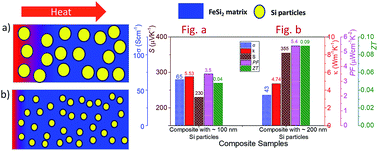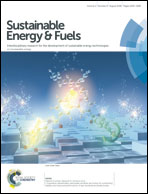Particle size effect on the thermal conductivity reduction of silicon based thermoelectric composites
Abstract
Composites of Si and transition metal silicides have been studied extensively for waste heat recovery applications because of their non-toxic, low cost and environmentally friendly nature. Composite samples made up of Si particles embedded in an Al doped β-FeSi2 matrix are synthesized by eutectoid decomposition of α-Fe2Si5−xAlx (x = 0.025, 0.05). The presence and uniform spatial distribution of Si particles are confirmed by means of X-ray diffraction and backscattered electron images of the samples, respectively. We measure the thermoelectric properties of our composite samples and find the highest figure of merit ZT = 0.09 for the sample with x = 0.05 at 773 K. Based on the interface thermal resistance predicted by the diffused mismatch model, it is shown that (i) the experimental values of the thermal conductivity of the composites are well described by the crowding factor model for different particles sizes and (ii) the matrix thermal conductivity can be reduced by half by inserting Si nanoparticles with a volume fraction of 50% and a radius of about 10 nm. Furthermore, a condition for lowering the thermal conductivity of particulate composites is derived, which can be useful to tune their microstructural parameters for thermoelectric applications.



 Please wait while we load your content...
Please wait while we load your content...